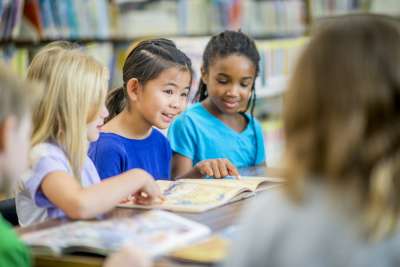Training for Older Students
What makes a good picture book? Ask students to brainstorm what they think makes a good picture book after reviewing several children's books. Students can do this in small groups and then share their list with the whole class to create a class list. Try to show them award-winning books, which might include Caldecott, Newbery, or Coretta Scott King award winners, and then ask them to add to their list. Students can go to the Web sites to look at the criteria for the Caldecott, Newbery, and Coretta Scott King awards. Based on this criteria and their own, have the class come up with their own rubric for high-quality children's books. They can use this rubric to select books to read to younger children and to write their own children's books.
Once the class has created the rubric, students could visit the local library, look at children's books, and use their criteria to choose a book to read to their buddy. If students have already met their book buddies, they may want to consider what books might interest their buddy. Students should choose a new book each time they meet with their book buddies.
Ask students to identify the audience for particular books and how they know a book is aimed at a certain audience. For example, some books may be aimed at children who are coping with a particular issue, such as being an older sibling, losing a tooth, and so forth.
Teachers can help older buddies choose what they will read to their younger buddies by preparing mini lessons. If older students are learning a specific skill in their reading, teachers may apply the same idea to a mini lesson. In turn, students choose books for younger readers that can help teach that skill.
Before going to the partner class, model good techniques and questioning to help students know what is expected of them. Pair students up and have them practice reading books to one another. Discuss how to make reading aloud effective. Demonstrate how to read with dramatic flair: voice changes, pauses, facial expressions, and so forth. It is important that students rehearse reading aloud so they know how to keep younger students' attention.
Older buddies may need some training to handle students who aren't paying attention, to look at and ask questions about the pictures, and to have students predict what will come next. Sample questions can be given to the older buddies to start conversations about the books, such as: Why did you like/not like the book? Who was your favorite character? Why? What would you have done if you were a character? Has anything like this ever happened to you?
After students return to their own room, have them reflect on the experience. Students should keep track of the books they read, each book's genre, and their buddies responses. Encourage them to reflect how their "lesson" went and what they might try the next time.
Training for Community Partners
In setting up a program that includes members of the community, you may want to provide training for the adult buddies. Make the meeting times and places explicit, and provide contact information. Give suggestions for reading with students who have attention problems, and provide a plan to support and assist the buddies in the event of any behavior problems.
Provide children's books or help adults choose books to read to or with their buddies. You may want to provide adults with a packet of activities, including discussion questions to complete with students before, during, and after they read the books.












